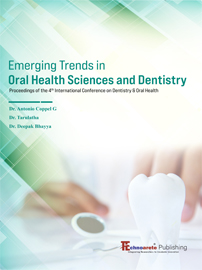


Department of periodontology,Chettinad dental college and Research institute ,Kelambakkam,Chennai,Tamilnadu,India
Corresponding Author:sai100aravind@gmail.com
Department of Periodontology, Chettinad Dental College and Research Institute, Kelambakkam, Chengalpattu district – 603103, India;
Corresponding Author: anithasubiksha@gmail.com
Department of Periodontology, Chettinad Dental College and Research Institute, Kelambakkam, Chengalpattu district – 603103, India;
Corresponding Author:agila.malai@gmail.comv
Department of Periodontology, Chettinad Dental College and Research Institute, Kelambakkam, Chengalpattu district – 603103, India;
Corresponding Author:d.smriti@gmail.com
Nanotechnology is the study of materials associated with components which are less than 1 to 100 nanometer .[1]The word (NANO) is derived from the greek word nanos which means dwarf which symbolises the word ‘Billionth’.It explains that a nanoparticle(10-9 )m is billion times smaller than a normal macro scale particle .These nano size particles cannot be viewed under ordinary microscope they need specialised high resolution microcopic devices devices to view them. The word nanotechnology was a controversy in the last centuries ,as it was not used in various fields in our life but nowadays it is evident that it is being used in several fields and also having various applications especaially in the field of dentistry. This usage is due its advantages that shows the good working of nanotechnolgy in nanoscales than in usual micro or macro scales .Due to its nano size it is expected to have various properties than normal particles because of its greater surface area . In denistry these nanoparticles has been started to be used to prepare more useful efficient materials and several devices These Nanoparticles have many advantages in dental field, such as (i) storing capacity and good stability in dental fluids , (ii) preparation methods are getting easier, (iii) easier large-scale manufacturing, (iv) Area specific controlled or timed release. Nowadays ,nanoparticles satisfy the needs of dentistry in deliver of medicated drug directly to diseased site , for example in to the gingival pocket or dento-gingival pouch /sac and also have controlled timely release of drugs.
[1] R.W. Kesall, I.W. Hamley, M. Geoghegan, Nanoscale Science and Technology, John Wiley & Sons, New Jersey, USA. 2005.
[2] L.X. Kong, Z. Peng, S.-D. Li, P.M. Bartold, Nanotechnology and its role in the management of periodontal diseases, Periodontology 40 (2006) 184 196.
[3] K. Henry, Z. Bao, Methods of fabricating nanoscale-to-microscale structures, US20080038170, 2008.
[4] A. Renugalakshmi, T.S. Vinothkumar, D. Kandaswamy, Nanodrug delivery systems in dentistry: a review on current status and future perspectives, Curr. Drug Deliv. 8 (2011) 586 594.
[5] N. Jain, G.K. Jain, S. Javed, Z. Iqbal, S. Talegaonkar, F.J. Ahmad, et al., Recent approaches for the treatment of periodontitis, Drug Discov. Today 13 (2008) 932 943
[6] Kristine R. Crews. Pharmacogenomics and individualized medicine: Translating science into practice. Clin Pharmacol Ther 2012;92:467–75.
[7] Evans WE, McLeod HL. Pharmacogenomics - drug disposition, drug targets, and side effects. New Engl J Med 2003;348:538-49.
[8] A. Dong, J. Huang, S. Lan, T. Wang, L. Xiao, W. Wang, et al., Synthesis of N-halamine-functionalized silica-polymer core-shell nanoparticles and their enhanced antibacterial activity, Nanotechnology 22 (2011) 19.
[9] Suzuki K. A review of computer-aided diagnosis in thoracic and colonic imaging. Quant Imaging Med Surg 2012;2:163–76
[10]Naranjo J, Poniachik J, Cisco D, et al. Oral Ulcers Produced by Mycophenolate Mofetil in Two Liver Transplant Patients. Transplant Proc. 2007;39(3):612-614. doi:10.1016/j.transproceed.2006.12.028
[11]Evans WE, McLeod HL. Pharmacogenomics - drug disposition, drug targets, and side effects. New Engl J Med 2003;348:538-49.
[12]Wang Y, Zhou J, Fu S, Wang C, Zhou B. A Study of Association Between Oral Lichen Planus and Immune Balance of Th1/Th2 Cells. Inflammation. 2015;38(5):1874-1879.
[13]Garrigue V.; Canet, S.; Dereure, O.; Panabieres, O.; Augias, D.; Chong, G.; Mourad G. ORAL ULCERATIONS IN A RENAL TRANSPLANT RECIPIENT: A
[14] Stiphout MAE Van, Marinus J, Hilten JJ Van, Lobbezoo F, Baat C De. Oral Health of Parkinson ’ s Disease Patients : A Case-Control Study. 2018;2018.
[15].Garrigue V.; Canet, S.; Dereure, O.; Panabieres, O.; Augias, D.; Chong, G.; Mourad G. ORAL ULCERATIONS IN A RENAL TRANSPLANT RECIPIENT: A
[16]A. Dong, J. Huang, S. Lan, T. Wang, L. Xiao, W. Wang, et al., Synthesis of N-halamine-functionalized silica-polymer core-shell nanoparticles and their enhanced antibacterial activity, Nanotechnology 22 (2011) 19.
[17] How To Use A Fluorescence Microscope [Internet]. Lab Manager. 2020 [cited 28 June 2020]. Available from: https://www.labmanager.com/lab-health-and-safety/how-to-use-a-fluorescence-microscope-19863
[18] W. Neuberger, Microbe reduction in the oral cavity with photosensitizers, US0052798A1, 2004
[19]S. Nugen, M. Hiorth, M. Rykke, G. Smistad, The potential of liposomes as dental drug delivery systems, Eur. J. Pharm. Biopharm. 77 (2011) 75 83.
[20]B. Moulari, H. Lboutounne, J.P. Chaumont, Y. Guillaume, J. Millet, Y. Pellequer, Potentiation of the bactericidal activity of Harungana madagascariensis Lam. ex Poir. (Hypericaceae) leaf extract against oral bacteria using poly(D,L-lactide-co-glycolide) nanoparticles: in vitro study, Acta Odontol. Scan. 64 (2006) 153 158.